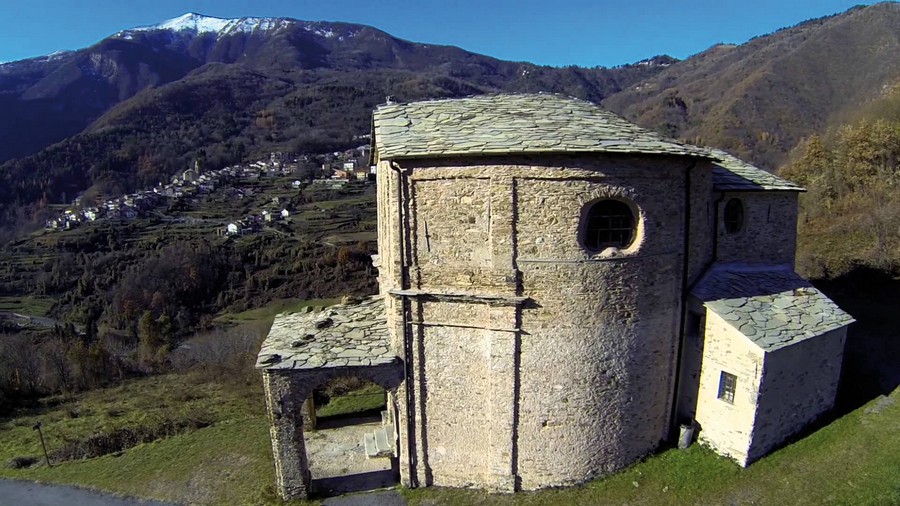Altitude: 778 m a.s.l.
Area: 31 sq km
Distance from Imperia: 32 km
Inhabitants: in 1881: 757 - in 2017: 226
Patron Saint Day: July 28th - Santi Nazario e Celso
Information: Municipality phone 0183 328713
As far as the etymology of the toponym is concerned, mentioned several times in various documents from the beginning of the thirteenth century, it preserves in its official form the most ancient phase of its name, while Mendàiga of oral elocution presents the normal phonetic evolution typical of the Ligurian dialect area.
The toponym is derived, with the suffix - atico and then inflected to the feminine as a villa attribute, from a base that remains however very uncertain, and can perhaps be identified with the pre-Roman name Mendus.
Another theory, though not supported by any reliable document, explains the origin of the toponym with the particular richness of water of the Mendatica district, from whose name "manda acqua" would derive the current name of the place.
The original village, consisting of the rustic shepherds' huts, was part of the fiefdom of the Clavesanas, "allies" of Genoa to whom the town was always subjected, however remaining unrelated, due to its scarce economic and strategic importance, to the wars of conquest by friends and enemies of the “Superb” city (i.e. Genoa).
Its origins date back to the time of the destruction of Albenga by the Longobards around the middle of the seventh century.
A part of the inhabitants, to escape the invaders, sought refuge in the hinterland going up to the head of the Arroscia valley where they gave origin to the now ruined old village.
Visit of the town
A few hundred meters before the built-up area, almost opposite the graveyard, take the dirt road to the left which, in three hundred meters, leads you to "Costa delle forche", a beautiful viewpoint where the convicts were executed.
There stands the fifteenth-century church of Santa Margherita on whose left side opens the black stone portal of 1512, protected by the arched roof in rough stones resting on stone shelves; from the medallions carved in the jambs two guardian wizards stand guard at the entrance.
From the nearby quadrangular window you can peek the interiors, which preserve frescoes by Pietro Guidi on the walls and in the apse perforated by a small window splayed as a slit; from the left side of the church, on which a secondary door opens, there is an almost vertiginous view of the valley below.
There begins the path that leads to the Arroscia waterfalls: after crossing the medieval bridge on the Grupin stream, and then Passo Luppa and Passo Serena, you’ll arrive in two hours of excursion to the beech forest where the Arroscia stream falls between the rocks with a jump of some twenty meters.
On June 24 is celebrated the "Shepherds' Feast", where local costumes are worn by men and women, and are played simple musical instruments once used as a signal during the months of the mountain pasture: goat horns and large marine shells.
Returning back and picking up the car, enter the village turning right at the fork that goes left to Monesi (a well-equipped winter sports center) and, parked in the clearing on the right of the road, walk up past one of the many stone fountains dated 1866 that serve the village.
After observing the black stone portal on the right in the open space, come to the other fountain above which, in the rooms that formerly were the prisons of the town, today is the modest Ethnographic Museum which exhibits work tools and household furnishings from the last century.
Continuing to go up to the right of the museum, when you reach the archway take to the left the porphyry paved flight of steps that lead to the church of the Saints Nazario and Celso, rebuilt in the eighteenth century and decorated on the bare façade with a marble tondo carved with an Agnus, which preserves of the original construction only the fifteenth-century bell tower in squared stones with a beautiful mullioned window under the belfry; in front of the left wall is the rectory, with a carved lintel of 1535.
Going up from the church along Via Mazzini, you’ll reach the oratory of Santa Caterina of 1896 with a portal enriched by a terracotta statue of the saint; further upstream there is the oratory of San Sebastiano and higher up, at the end of the inhabited area, the church of San Rocco with two large marble angels on the sides of the altar.
Back to the car continue on the Provincial Road in the direction of Cosio D'Arroscia which you’ll reach after crossing the wood.


